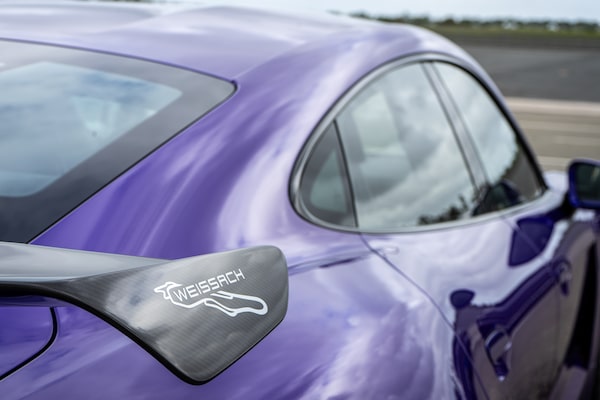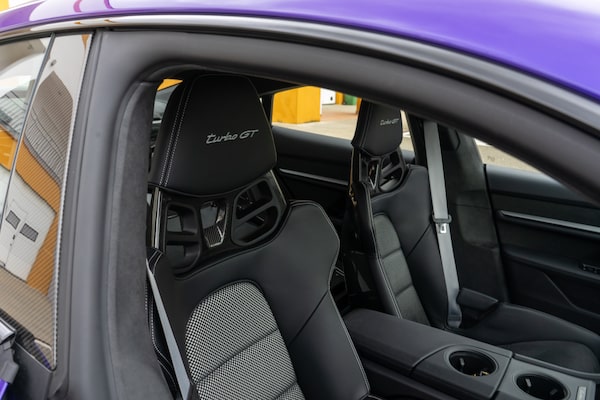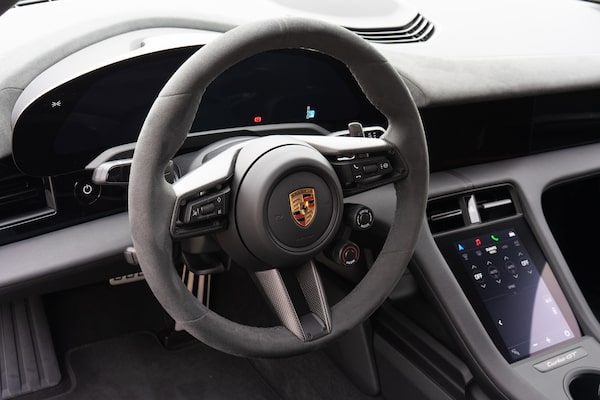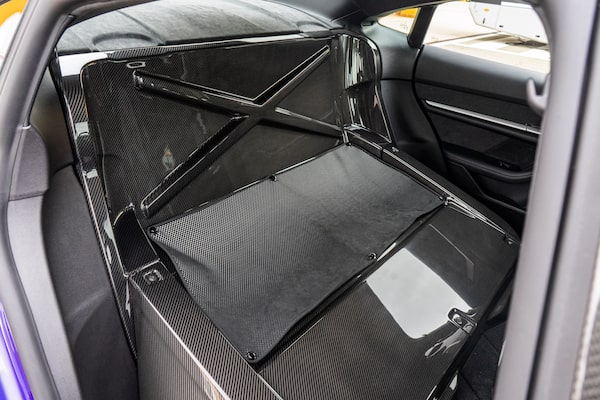
The 2025 Porsche Taycan Turbo GT has an impressive 1,092 horsepower and 1,300 lb-ft torque, during launch control.Kunal D’souza/The Globe and Mail
The new Porsche Taycan Turbo S sets new standards for fast cars, not just fast EVs. It’s not like it was slow before, but the 2025 refresh is over the top.
With over 1,000 lb-ft of torque during a launch, it takes vehicular acceleration to new heights. But it seems Porsche wasn’t done because the Taycan Turbo S is yesterday’s news. Today, it’s all about the new Taycan Turbo GT.
We first saw the Turbo GT badge applied to the Cayenne SUV, and it brought with it more power and track-ready hardware like carbon ceramic brakes. The Cayenne Turbo GT set a precedent for the Taycan and, as usual, Porsche dived deep into the innards of its electric sports sedan and extracted every last gram of performance it could.
The Taycan Turbo GT uses the same dual-electric motor setup as the Turbo S, but uses a more powerful 900-ampere pulse inverter. A pulse inverter is an unsung hero in an electric drivetrain. Everyone focuses on the batteries and motors, but these components are just as crucial. Their sole job is to convert the direct current from the battery into the three-phase current required by the electric motors. All of the drive energy passes through them, and they are critical to the efficiency, safety and reliability of the drivetrain during acceleration and energy recuperation. When these components don’t work properly, energy gets lost in the form of heat and efficiency plummets. The pulse inverter in the Turbo GT helps it produce up to 1,092 horsepower and an unimaginable 1,300 lb-ft of torque when using launch control. (A Honda Civic, by comparison, produces a measly 158 horsepower and 138 lb-ft of torque.)
There’s less weight to move around, too, as the Turbo GT is 75 kilograms lighter than the Turbo S, achieved mainly through carbon fibre trim pieces, carbon bucket seats (which aren’t available in North America), a lightweight luggage compartment and special lightweight 21-inch wheels. Carbon ceramic brakes are also part of the deal and shave even more of the curb weight.
The Turbo GT looks the part, especially in the new Purple Sky Metallic hue. It has a new front spoiler with distinctive side blades and a pronounced lip spoiler on the trunk called a “gurney flap.”
There’s also the lightweight Weissach package, which is a no-charge option. It takes things to an extreme level by ditching everything not necessary for performance, including the rear seats, and adding a large fixed carbon wing on the trunk lid. There’s an additional 70 kilograms saved with this package that deletes the Bose stereo, the clock on the dashboard and one of the two charging ports. It’s about as extreme as a Taycan can get, and I have to admit that I found it a bit comical to open the rear doors of a four-door sedan only to be greeted by a glossy carbon fibre panel and no place to sit.
Review: Porsche’s updated Taycan is the finest electric sports sedan on sale
The Turbo GT with the Weissach package recently crushed the lap record at the Nurburgring race track in Germany, not just for production EVs but for production four-door cars of any powertrain type. Its time of 7 minutes 7.55 seconds was an astonishing 26 seconds faster than the last Taycan Turbo S to go around the 20.8-kilometre ring. It also set a production EV record at Laguna Seca Raceway in California, which should surprise no one.
It really feels like Porsche made this car just to set lap records and they don’t even care if they sell any because who would buy a Taycan with no rear seats? Okay, so there are likely going to be more than a few takers and for those who get one, take it to a track. It would be a crime not to, because there’s just no other reason to get a Turbo GT.
Porsche took us out to Circuito Monteblanco, a small track near Seville, Spain and put us behind the wheel of a Turbo GT with the Weissach pack, where we experienced what it feels like to accelerate from zero to 200 kilometres an hour in 6.4 seconds. (Yes, that’s 200 kilometres an hour.) The wild part is it will continue to pull relentlessly until it reaches its top speed of 305 kilometres an hour. The official zero-to-100 time is 2.2 seconds, but I wouldn’t be surprised if independent tests found it to be faster.
The Turbo GT is a beast on the track. Lap after lap, nothing seems to flummox it. The giant carbon ceramic rotors are so effective at scrubbing off speed and show no signs of fading after repeated heavy applications. In the Turbo GT, the “push to pass” button is called “Attack Mode” and rightfully so. Think of it as the “Nitro” button on an arcade racer because that’s exactly how you use it. It provides a 120-kilowatt (161-horsepower) wallop every time you push the button on the drive mode controller or pull the right shift paddle, depending on how you have it configured. There’s a four-second cool down time but “Attack Mode” is a highly effective tool on the track and was used to great effect during the lap record runs.
In the hands of someone who cannot set lap records, the Turbo GT is almost too easy to drive fast. It feels light and agile and more powerful than anything I’ve ever driven. Even on a wet track, the grip from the new Pirelli Trofeo RS tires, developed for the Taycan, is prodigious and it feels like we never have to slow down. You’d think with more than 1,000 horsepower it would be an uncontrollable mess, but the Taycan is no more difficult to drive than a Honda Civic.
Porsche effectively demonstrated just how capable the new Taycan can be with the Turbo GT and it’s really the best EV you can buy today if driving dynamics are high on your list of wants. But with a starting price of $270,000, with or without the Weissach pack, it’s not exactly an attainable item for most people. As good as it is, the Turbo GT only highlights how impressive the entry-level Taycan 4S is at half the price. That’s the one we’d have in a heartbeat.
Tech specs
2025 Porsche Taycan Turbo GT
- Base price: $270,000 plus $2,950 for freight and predelivery inspection, plus tax, including the luxury tax
- Powertrain / Battery: Dual electric motors which produce 1,092 horsepower (combined during launch control) and 1,300 lb-ft torque (during launch control) / 97-kilowatt-hours
- Transmission / Drive: Two-speed /all-wheel drive
- Curb weight: 2,234 kilograms
- Energy consumption (litres equivalent per 100 kilometres) / Range: To be announced / 558-630 kilometres
- Alternatives: Tesla Model S Plaid, Lucid Air, F-18 Hornet

The Turbo GT looks the part, especially in the new Purple Sky Metallic hue.Kunal D’souza/The Globe and Mail
Looks
It’s a Taycan, just a bit racier, and the lightweight wheels are stunning. The Weissach pack can’t be missed with the large wing and telltale logos.

Carbon bucket seats on the 2025 Porsche Taycan Turbo GT.Kunal D’souza/The Globe and Mail
Interior
It’s a four-door sedan with a glossy carbon fibre plate where rear seats should be. It’s extreme but it’s optional. If you don’t want to set your own lap records, the Turbo GT without the Weissach pack would be a much more livable choice.
Performance
Accelerate any faster than this Turbo GT and you risk tearing through the fabric of time. You can launch a Turbo GT over and over again as long as there’s enough charge in the battery. It will also go around a racetrack faster than any other four-door car and most sports cars.

Attack mode provides a 120-kilowatt (161-horsepower) wallop every time you push the button on the drive mode controller.Kunal D’souza/The Globe and Mail
Technology
Attack Mode was designed to function just like it does in the 99X race cars Porsche uses to compete in Formula E. The Taycan Turbo GT is a video game come to life.

The Weissach package includes no rear seat to save weight. It is strange to open the rear doors and see no seat.Kunal D’souza/The Globe and Mail
Cargo
It’s the same as any other Taycan with an 84-litre front trunk (frunk) and a 367-litre trunk under the carbon wing.
The verdict
A triumph on the track, but we’d still get a 4S.
The writer was a guest of the automaker. Content was not subject to approval.
Shopping for a new car? Check out the new Globe Drive Build and Price Tool to see the latest discounts, rebates and rates on new cars, trucks and SUVs. Click here to get your price.